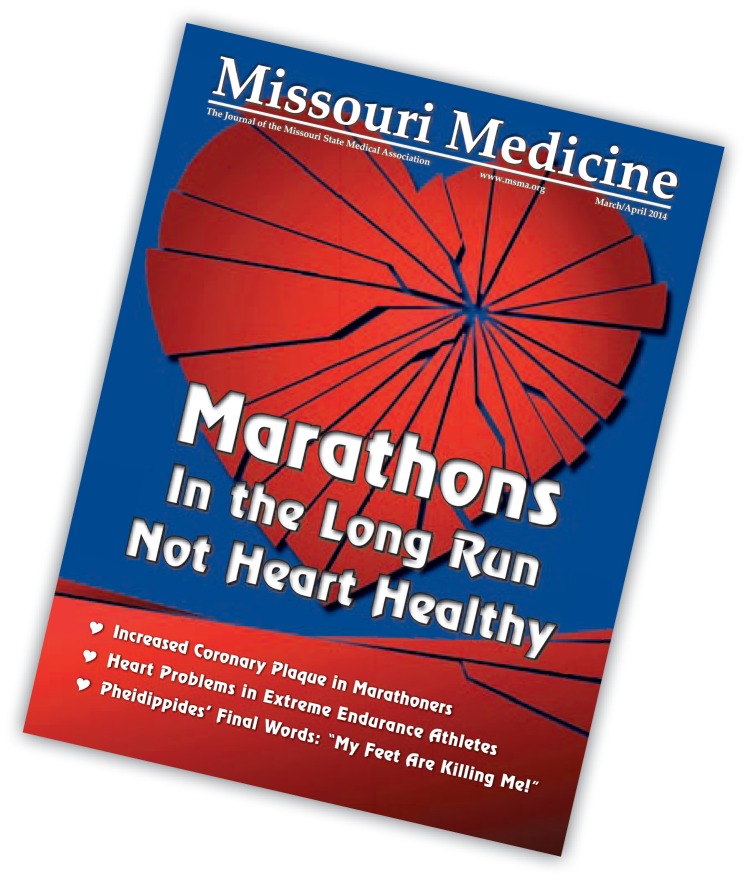Marathons: In the Long Run Not Heart Healthy! This was our call-out cover message in the notable March/April 2014 issue of Missouri Medicine.1 With the passage of time - four years to be exact - it’s now apparent Missouri Medicine authors got it right. Their naysayers got it wrong. The research paper by Robert S. Schwartz, MD, et al., an editorial review by eminent cardiologists Carl J. Lavie, MD, and Peter A. McCullough, MD, and the editorial outlining my ‘heart of stone’ from over three decades of marathon running remain our most widely publicized original research. They were noted and quoted in the Wall Street Journal, New York Times, and Runner’s World to modestly name only a few.
In this current 2018 editorial and in the following scientific article, “The Goldilocks Zone for Exercise: Not Too Little. Not Too Much,” by James H. O’Keefe, MD, Evan L. O’Keefe, MS, and Carl J. Lavie, MD, (see page 98) Missouri Medicine updates subsequent research that has vindicated our earlier conclusions and assertions. New message: Frequent exercise is extremely important to health but in moderate amounts at low to moderate intensity. Long duration-high intensity exercise is not heart healthy. Moderation in intensity and duration is especially important after 40–45 years of age.
The primary 2014 conclusion by Schwartz, Kraus, O’Keefe et al.1 was the finding that veteran marathon runners had higher coronary artery calcium scores (CACS) than age matched non-marathoner cohorts. CACS, determined by CT scanning, is a surrogate for coronary artery plaque burden. Normal value is 0 and values higher than 100 raise concerns for coronary artery heart disease and increased risk for cardiovascular events such as myocardia infarct, serious arrhythmias, and sudden death. All things most marathoners, myself included, thought they were running away from, not running towards, by full bore running many miles for many hours every week.
Subsequent studies have confirmed that marathontype, excess exercising is associated with elevated CACS. At the most extreme end of excess exercising, CV events may even be more common than in non-exercisers. Many examples exist of what is essential and/or healthy in small or moderate amounts may be detrimental or even fatal in large amounts such as medication dosage, trace elements, water or alcohol ingestion. In their 2014 editorial overview, McCullough and Lavie also raised a cautionary note about excessive marathon-type exercise, posed excellent mechanisms by which hyper-exercise might damage the heart and its arteries and cause elevated CACS. They called for more research and wondered if the elevated CACS in marathon runners would carry the same increased risks of CV events as similar scores in non-exercisers with high CV risk factors (smoking, obesity, hypertension, diabetes, etc.).
While I certainly can be accused of having observational bias, my reading of the cardiovascular literature suggests that hyper-exercisers with otherwise few CV risk factors tend to form high calcium density, lower volume fibrous atheroma that are more stable and less prone to cause CV events than the low calcium density, high volume lipid-filled plaque that more commonly causes CV events. Newer techniques of coronary artery testing are able to determine which types of atheroma predominate.
In my 2014 editorial, “Pheidippides’ Final Words: ‘My Feet Are Killing Me!’” I outlined my personal health problems related to over 35 years of marathon running; the development of what was then called “lone” atrial fibrillation and a CACS of 1606, so high Dr. O’Keefe, my personal physician, called me at home and asked if my wife would drive me back to his office for more tests. (These turned out fine.) Subsequently I stopped running, lost a few pounds, made modest changes in my diet, went on low dose statin and aspirin, and do six days/week low intensity exercise such as walking, exercise bike, treadmill at the snail-like speed of 3.1 mph, or swim for about an hour. Thus far no more atrial fibrillation, no cardiovascular events, and I’m almost completely off blood pressure medication. I began marathon running in the belief it was healthy especially for my cardiovascular system. Had I known then what we now know about excess endurance exercise, I would have patterned my exercise program to match the O’Keefe-Lavie Goldilocks Zone recommendations.
That pretty much gets to the ‘heart’ of the matter. I am gratified for the role Missouri Medicine and this outstanding group of authors played in disabusing the belief that lifelong marathon running-type excessive exercise is beneficial. A prescription for frequent age-specific mild/moderate exercise should be one of the first prescriptions every physician writes for their patients … and themselves.
Biography
Missouri Medicine Editor John C. Hagan, III, MD, was very confident that his long-distance running would guarantee a healthy heart. He now believes 45 years of maximum endurance exercising contributed to his atrial fibrillation and high coronary artery calcium score. Left, Dr. Hagan runs the Kansas City Hospital Hill Half Marathon in 1988.
Contact: jhagan@bizkc.rr.com

References
- 1.Missouri Medicine. 2014 Mar-Apr;111(2):89–101. [Google Scholar]



